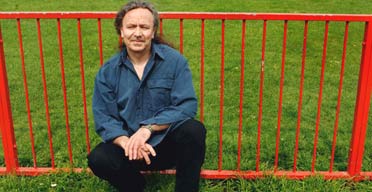James Dillon at the Proms

On Thursday night The BBC Scottish Symphony Orchestra and Martyn Brabbins, performed La navette by James Dillon, giving the work its first UK performance. Born in 1950, Dillon could be described as a ‘New Complexity” composer, along with Brian Ferneyhough, Michael Finnissy, Richard Barrett, among others. He has written lots of music, a lot of which has been played on the Proms concerts and other places, and he is celebrated in the UK, where is definitely considered to be an important composer. Although his music is not so well known in the US, he has done a fair amount of teaching there, including at Oberlin and The University of Minnesota, where he is currently on the faculty.
The title of La navette is translated as shuttle, in this case a shuttle used for weaving. This piece, which dates from 2001,was written at the same time as Dillion’s music theater piece Philomela, finished in 2004, and it refers, at least obliquely, to the Greek myth which is the story of the opera. In Ovid’s version of the myth, Philomela is raped by Tereus, the husband of her sister Procne and king of Thrace. To keep Philomela from telling about his crime, Tereus cuts out her tongue. Philomela nonetheless reveals her story by weaving it into a cloth that she sends to Tereus. When Procne discovers what has happened, she kills Tereus’s–and her–son and feeds him to Tereus in revenge. The gods eventual intervene and turn all three of them into birds; Philomela, who becomes the nightingale, has her voice restored in the bird’s song. As Tim Rutherford-Johnson writes in his program note, the reference to the loom’s shuttle evokes dark and violent mythology, but “it also speaks of hope, ingenuity, and resilience: all qualities possessed by Philomela as she passed the shuttle back and forth” to weave the cloth that will tell her story. ” La navette” can also be translated as ‘the commute,’ however, and Dillon also intended to imply a continuous movement from one state of being to another.
La navette is a twenty minute piece for a very large orchestra. It begins with very slow music which is presented in several simultaneous strands. These strands are eventually separated, but together they give at the beginning the impression of luminous, motionless music quietly throbbing. After developing more activity, this music transforms itself into a steady movement (suggesting the back and forth of the loom?), and then into a sort of quietly heavy inexorable thumping (imagine the Sacrificial Dance done quietly and in very slow motion). Although the beat of this section is quite a bit faster, the staticness of the pitches and particularly of the harmony, militates against the perception of increased speed. As in the two other sections, this one builds in volume and density, and finally ends, neither with a bang nor a whimper, but rather in sort of last quiet gasp. Given the amount of stuff going on most of the time, one wouldn’t necessarily expect the texture of La navette to be as transparent or to sound as luminously as it does, or that so many of the details would be so clearly audible. This has not been the case is other of Dillon’s pieces that I’ve heard. The sound of it is always seductively attractive and appealing. In terms of its continuity, I could imagine one thinking that it was hypnotic and I could imagine one thinking that it was slightly tedious after a while; I’m inclined more toward the former view.
This very difficult piece was on a quite long program with other pieces, which, though standard repertory (Sheherazade, the Tschaikovsky Second Symphony, the Lizst First Piano Concerto, and the Mozart Overture to The Impresario–not in that order), were not at all easy; it must have been very tiring for the orchestra. Martyn Brabbins in all the pieces, but especially in the Dillon, where it was especially welcomed, presented lucid, no nonsense, beautiful performances.
Prior to the Albert Hall concert, the Royal Scottish Academy MusicLab, presented a composer portrait of Dillon’s Music across the street at the RCM. Zone (..de azul), for a fairly large ensemble, a relatively recent piece is a mellifluous, shimmering, and (as Adrew McGregor described it during the event) iridescent piece. ….Once Upon a Time, which Dillon described as his Opus One (everything earlier having been withdrawn, and therefore is being remembered as in a story) is for the same instrumental combination as Varese’s Octandre, and, in fact, demonstrates, in its textures and the shaping of its instrumental lines, Dillon’s great admiration for Varese. Between those two pieces, both of which got slam bang performances, conducted by Jessica Cottis, were two gently contemplative piano pieces, Dragonfly and Charm played by the excellent pianist Ed Cohen.
Both these concerts are available for listening on the BBC iplayer (http://www.bbc.co.uk/programmes/b007v097/episodes/player) for a week after the concert.